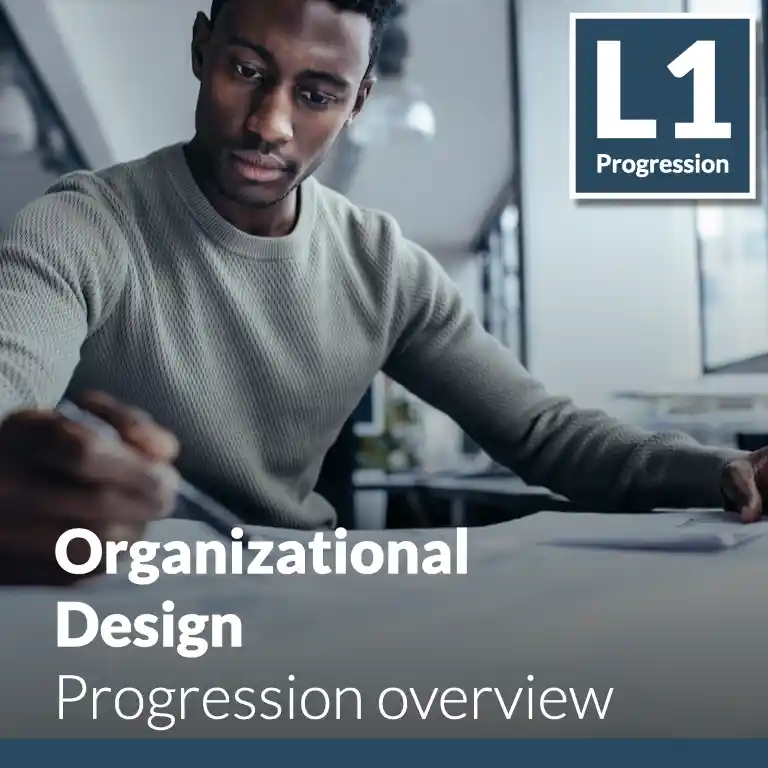Enjoy instant access to a scalable system of proven practices and execution-ready tools. Built to launch strategic HR programs 5X faster!
✓ Enjoy platform access
✓ Create your HR roadmap
✓ View open content in library
✓ Access dozens of practices:
⤷ The HR Strategy program
⤷ Explainers and deep dives
⤷ Supplemental guides
⤷ Insight articles
⤷ Weekly best practices
⤷ And more!
100% Free. No credit card required.
This guide is part of a progression set comprised of Core, Advanced, and Emerging Organizational Design practices.
Organizational design includes activities to outline and implement an organization that can enable the pursuit of the business strategy and organizational goals. These activities include clarifying the scope and structure of the organizational design, articulating the business strategy, as well as identifying organizational priorities and principles to guide the design of the organization. They also include selecting an organizational structure, designing roles, and assessing, selecting, and placing people into roles to enable the organization to pursue its strategy and realize its goals.
These activities include determining which parts of the structure are to be designed or redesigned and specifying who will oversee the effort and how decisions will be made. It engages business and HR leaders in understanding the business objectives and how they are impacted by environmental (external and internal) challenges, as well as customer and other stakeholder requirements. Critical practices include selecting an appropriate organizational structure from classic models that address key design considerations to drive an efficient and effective operating model. It involves designing individual jobs/roles aligned with the organizational capabilities needed to meet the purpose and function of the organization and follow-up with the assessment, selection, and placement of people into roles to enable the organization to pursue its strategy and realize its goals.
A good business strategy is, by itself, not enough to achieve success. Companies also need well-designed organizations aligned with business strategy to clarify the human capabilities necessary to accomplish that strategy and empower people to perform their best by creating a formal structure for the working environment and relationships. Designing and implementing the proper organization can be challenging, given that companies often face dynamic business environments, and effective organizational design requires the coordination of various aspects of the organization. This set of practices is designed to create a formalized and disciplined approach to defining a structure that simultaneously meets business and human performance requirements. It accomplishes this by guiding the organization of people according to the necessary workflows that create value and purpose for the enterprise.
A thoughtful, comprehensive approach to organizational design can propel organizations to unlock the potential of their people and achieve faster growth and improved performance. This process is not possible without the active involvement of leaders and experts in operational considerations. Their insights and expertise are crucial in determining improved ways to build organizations and teams that can better meet the needs of the business and its partners, customers, and stakeholders. It provides the structure needed to help employees understand their role and relative positioning within the larger organization for purposes of governance and decision-making and -support. A well-designed structure clarifies to leaders, managers, and employees where to look for strategic guidance, workflow clarification, and other resources for collaboration and expertise.
By leveraging these practices and steps, a comprehensive set of recommendations for structuring a new business or function or restructuring an existing one can be made in a disciplined manner. The process creates an organizational design deeply aligned with the business purpose and imperatives, is “owned” by key decision-makers engaged in its design, and addresses the flow from business strategy to needed human capabilities to individual role design. This results in a clear understanding of the critical tasks to be completed in workflows aligned with each part of the organization, and each task is assigned to a set of individual roles from which position requirements can ultimately be developed. It creates a structured approach to the identification and justification of staffing requirements and manages the placement of individuals into specific roles. It creates an organizational structure that can optimize the appropriate levels of employee management/oversight needed given the nature of the work, collaboration, and communication between employees and teams and how the teams interact and make decisions.
Engaging the appropriate stakeholders, utilizing the proper information, and ensuring that the newly designed organization is aligned with the business strategy.
Selecting and tailoring a structure that meets the needs of the organization and determines how the organization will work together to implement its strategy and achieve its goals.
Providing clarity for the work required to achieve the organization’s objectives and creating a shared understanding regarding who will perform the work.
Leveraging a structured approach to fairly and equitably evaluate talent and place people into defined roles.

Enjoy instant access to a scalable system of proven practices and execution-ready tools. Built to launch strategic HR programs 5X faster!